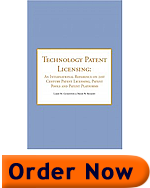[Summary of Chapter 3]:
Although bilateral licensing may include any kind of patents, and may indeed include trade secrets or other non-patent intellectual property, aggregated licensing, such as licensing through patent pools or platforms, is permitted by the antitrust authorities only for patents which are “essential to implementation” of the relevant technical standard. In Chapter 3, the concept of “patent essentiality” is explained. A specific process for evaluating patent essentiality is described. There are many issues, including possible points of confusion or difficulty, related to creation and operation of a method for evaluating patent essentiality. Sixteen of these issues are listed and explained.
=\=\=\=\=\=\=\=\=\=\=\=\=\=\=\=\=\
[Brief Excerpt from Chapter 3, pp.88, 133]:
Patents which are essential for a particular technical implementation of an international standard have a much greater chance of generating commercial value. Therefore, the value of a particular patent depends, in large degree, on whether it is essential to a technical implementation. Today, there is substantial confusion about which patents are essential for any technical implementation of a standard. If the standard explicitly incorporates a patent, then of course there is little problem, but that happens only rarely. More commonly, each patent must be evaluated by someone, according to some methodology, who will determine whether the patent is essential according to that methodology…The determination of patent essentiality is of critical importance to the successful implementation of international technical standards.
To Continue To Chapter 4 –Click Here.
